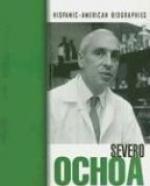|
This section contains 364 words (approx. 2 pages at 300 words per page) |
World of Genetics on Severo Ochoa
Severo Ochoa is best known for being the first to synthesize ribonucleic acid (RNA) outside the cell. He has also discovered several important metabolic processes. For his work with RNA, he received the 1959 Nobel Prize in physiology or medicine, along with his colleague, American biochemist Arthur Kornberg.
Ochoa was born in Luarca, Spain, where his father was a lawyer, and graduated from the University of Malaga in 1921. He received a medical degree in 1928 from the University of Madrid. After further studies in experimental biology, in 1940 he joined the Medical School faculty of Washington University in St. Louis. In 1942, he moved to New York University's College of Medicine, becoming chairman of the biochemistry department in 1954. Ochoa became an American citizen in 1956.
Ochoa's synthesis in 1955 of RNA was pure serendipity--an unexpected byproduct of his study of the way cells use glucose that is stored as ATP (adenosine triphosphate). Ochoa and a French associate, Marianne Grunberg--Manago, had purified an enzyme (now called polynucleotide phosphorylase) from the bacteria Azotobacter vinelandii. The two scientists were trying to study its reactions with ATP and other base-sugar combinations (called nucleosides) with one or three phosphate groups attached. No reaction occurred. However, when they added the enzyme and some magnesium to a nucleoside with two phosphate groups (diphosphate), over half of the nucleoside disappeared and some phosphorus was freed.
Ochoa traced the nucleoside to a new molecule that ultraviolet chromatography identified as a nucleotide. He then repeated the reaction with other nucleoside--diphosphates, in each case finding a nucleotide. Further analysis showed that the sugar was ribose, meaning that the reaction produced ribonucleic acid (RNA). Since the reaction was also reversible, Ochoa concluded that adding and removing phosphorus groups is a major mechanism in the synthesis and breakdown of nucleotide chains. Ochoa and other scientists used this method to decipher the genetic code. Later studies by others showed that RNA polymerase, instead of Ochoa's enzyme, is the main RNA synthesizing enzyme.
Ochoa is also known for his work on how the body uses carbon dioxide, and he helped identify a key compound in the metabolism of carbon dioxide. Ochoa also identified Krebs cycle reactions leading to energy storage in phosphate bonds.
|
This section contains 364 words (approx. 2 pages at 300 words per page) |


